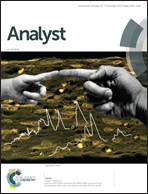Direct comparison of derivatization strategies for LC-MS/MS analysis of N-glycans†
Abstract
Protein glycosylation is a common post-translational modification that has significant impacts on protein folding, lifespan, conformation, distribution and function. N-Glycans, which are attached to asparagine residues of proteins, are studied most often due to their compatibility with enzymatic release. Despite the ease of N-glycan release, compositional and structural complexity coupled with poor ionization efficiency during liquid chromatography mass spectrometry (LC-MS) make quantitative glycomic studies a significant challenge. To overcome these challenges, glycans are almost always derivatized prior to LC-MS analyses to impart favorable characteristics, such as improved ionization efficiency, increased LC separation efficiency and the production of more informative fragments during tandem MS. There are a number of derivatization methods available for LC-MS analysis of glycans, each of which imparts different properties that affect both glycan retention on LC columns and MS analyses. To provide guidance for the proper selection of derivatizing reagents and LC columns, herein, we describe a comprehensive assessment of 2-aminobenzamide, procainamide, aminoxyTMT, RapiFluor-MS (RFMS) labeling, reduction and reduction with permethylation for N-glycan analysis. Of the derivatization strategies examined, RFMS provided the highest MS signal enhancement for neutral glycans, while permethylation significantly enhanced the MS intensity and structural stability of sialylated glycans.



 Please wait while we load your content...
Please wait while we load your content...